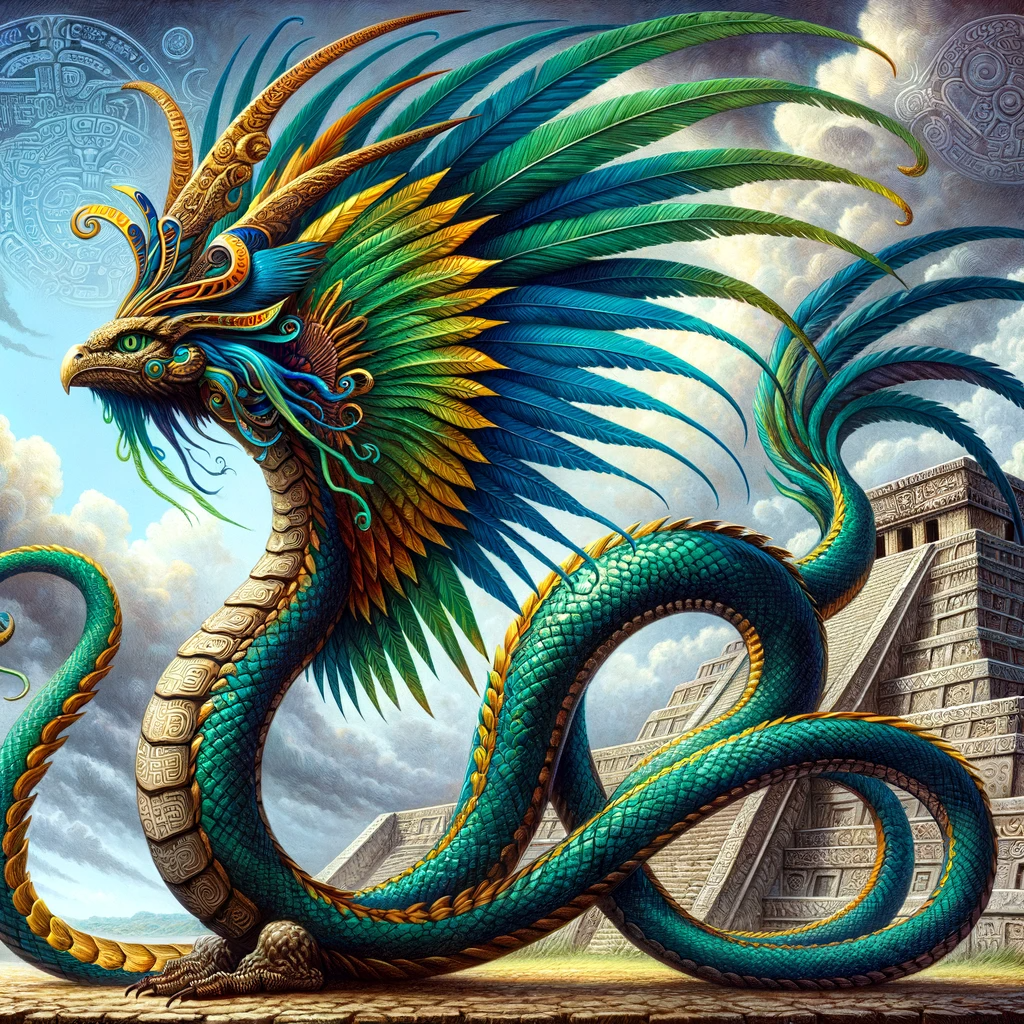
In the pantheon of Mesoamerican deities, few are as renowned or as enigmatic as Quetzalcoatl, the Feathered Serpent. A figure of myth and legend, Quetzalcoatl's presence permeates the ancient cultures of the Aztec, Toltec, and other civilizations of pre-Columbian America. His name, derived from the Nahuatl language, combines "quetzalli," signifying feathers, with "coatl," meaning serpent, epitomizing his unique depiction as a serpentine creature adorned with the vibrant plumage of the quetzal bird.
Origins and Mythology
Quetzalcoatl's origins are shrouded in antiquity, with his worship predating the Aztecs. He is often identified with Ehecatl, the god of wind, and is believed to have been a creator deity involved in the creation of mankind. In some myths, he is one of the sons of the primordial dual god Ometeotl, embodying the principles of life and fertility.
Cultural Significance
For the Aztecs, Quetzalcoatl was not just a god of the skies and earth, but also a symbol of death and resurrection. His dual nature represented the eternal cycle of life, embodying both the earthly serpent and the heavenly bird. As a deity of learning and knowledge, he was revered by scholars and priests, and his patronage extended to craftsmen and artists. The city of Tula and the legendary Toltec civilization are often associated with Quetzalcoatl, where he was revered as a cultural hero and a bringer of civilization.
Quetzalcoatl in Aztec Society
In Aztec society, Quetzalcoatl's influence was profound. He was central to various religious ceremonies, especially those related to agriculture, as he was associated with maize, a staple crop. His temple, the Temple of the Feathered Serpent, is a prominent archaeological site in Teotihuacan, featuring intricate stone carvings that depict his iconic image.
Quetzalcoatl and the Spanish Conquest
The arrival of the Spanish conquistadors in the 16th century added a layer of complexity to the legend of Quetzalcoatl. Some sources suggest that the Aztec ruler Moctezuma II believed the conquistador Hernán Cortés to be Quetzalcoatl returning from the east, a belief that may have influenced the initial interactions between the Aztecs and the Spanish. This narrative, however, is debated among historians and may be more myth than fact.
Legacy and Interpretation
Today, Quetzalcoatl remains a potent symbol in Mexican culture and heritage. His image appears in various forms of art, literature, and cultural discourse, symbolizing the rich and complex heritage of the pre-Columbian era. Scholars continue to debate and interpret his role, both in the mythological realm and in the sociopolitical landscape of the ancient Aztec world.
In conclusion, Quetzalcoatl, the Feathered Serpent, stands as a testament to the rich mythology and cultural depth of the ancient civilizations of Mesoamerica. His legacy, transcending mere religious worship, reflects the profound philosophical and cosmological understandings of the people who revered him.
Origins and Mythology
Quetzalcoatl's origins are shrouded in antiquity, with his worship predating the Aztecs. He is often identified with Ehecatl, the god of wind, and is believed to have been a creator deity involved in the creation of mankind. In some myths, he is one of the sons of the primordial dual god Ometeotl, embodying the principles of life and fertility.
Cultural Significance
For the Aztecs, Quetzalcoatl was not just a god of the skies and earth, but also a symbol of death and resurrection. His dual nature represented the eternal cycle of life, embodying both the earthly serpent and the heavenly bird. As a deity of learning and knowledge, he was revered by scholars and priests, and his patronage extended to craftsmen and artists. The city of Tula and the legendary Toltec civilization are often associated with Quetzalcoatl, where he was revered as a cultural hero and a bringer of civilization.
Quetzalcoatl in Aztec Society
In Aztec society, Quetzalcoatl's influence was profound. He was central to various religious ceremonies, especially those related to agriculture, as he was associated with maize, a staple crop. His temple, the Temple of the Feathered Serpent, is a prominent archaeological site in Teotihuacan, featuring intricate stone carvings that depict his iconic image.
Quetzalcoatl and the Spanish Conquest
The arrival of the Spanish conquistadors in the 16th century added a layer of complexity to the legend of Quetzalcoatl. Some sources suggest that the Aztec ruler Moctezuma II believed the conquistador Hernán Cortés to be Quetzalcoatl returning from the east, a belief that may have influenced the initial interactions between the Aztecs and the Spanish. This narrative, however, is debated among historians and may be more myth than fact.
Legacy and Interpretation
Today, Quetzalcoatl remains a potent symbol in Mexican culture and heritage. His image appears in various forms of art, literature, and cultural discourse, symbolizing the rich and complex heritage of the pre-Columbian era. Scholars continue to debate and interpret his role, both in the mythological realm and in the sociopolitical landscape of the ancient Aztec world.
In conclusion, Quetzalcoatl, the Feathered Serpent, stands as a testament to the rich mythology and cultural depth of the ancient civilizations of Mesoamerica. His legacy, transcending mere religious worship, reflects the profound philosophical and cosmological understandings of the people who revered him.